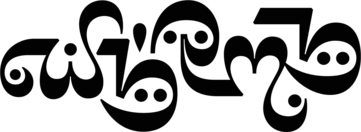Shiva Nallaperumal Makes the Forbes India 30 Under 30 List
As one of the youngest members of the Forbes list, Nallaperumal finds himself as an ambassador for the Indian type & design community.
Shiva Nalluperumal, shot for Forbes India by Selvaprakash Lakshmanan
Forbes Magazine’s annual tradition of their “30 Under 30” lists is always met with acclaim worldwide and Forbes India is no different. They published their own list earlier this month and making the list is a familiar face to the type community, Shiva Nallaperumal. At 24, he’s one of the youngest recipients on this year’s list, and represents the type and graphic design community with his deep portfolio of work.
Although his background and journey to the list is well documented, it's worth noting that Shiva is no stranger to awards. He presented his work at TypeCon 2015 as the winner of the SoTA Catalyst Award that year. He has also received the Certificate of Excellence in Exhibition Design from the International Society of Typographic Designers (ISTD) the year before.
““I would like to dispel any ideas that this honor was because of my own sheer hard work.””
Any conversation with Shiva will quickly expose his humility when it comes to his work. “I would like to dispel any ideas that this honor was because of my own sheer hard work. I have always been pushed and empowered by the kindness of many friends, collaborators and guides all my life. Kulture Shop, a brand and a platform for young designers and visual artists in India (who I’ve been working with for a couple of years) nominated me.”
The Forbes list has also brought a new avenue to the deep pool of design talent flowing under the radar in India. “I feel the recognition of typography and its core importance in the Indian mainstream will open up many more avenues for us.”
The Indian Design Community
Understanding this part of the world can sometimes feel inaccessible to westerners, but it is incredibly important for the globally minded designer today. Nallaperumal finds himself in a position to be an ambassador, saying:
““I am most interested in the Indian-ness of design, embracing our plurality, understanding an identity that is truly Indian.””
We asked him to unpack this for us, to introduce the current state of the Indian design scene and what folks in the west can do to better appreciate and promote the success and work of these designers:
“The history of Indian graphic design is both breathtakingly diverse as well as notoriously under-documented. There are 29 states and 7 union territories in the subcontinent and almost every state has its own language and script. This means different literary histories, vastly diverse cultures, fashion, food, political situations... and graphic design to visually interpret these.”
“The vast amount of local designers of books, magazines, posters etc. rejected the modernist influence of Europe and America in search of a truly original Indian style that embraced our plurality instead of trying to bring the whole country under one design language, but most of these designers never documented their work or were given proper credit. Although many of these beautiful objects exist, it is hard to track down the designers. Another problem was that we never had organizations (like AIGA or AGI) to bring these works together, document and celebrate them. By the time globalization hit India, many of these designers were already in obscurity.”
Reviving India’s Graphic Design History
But in the past decade, there has been revived interest in the Indian identity of pluralism with many designers consciously practicing it to find original solutions. Codesign’s wonderful “Dekho” is the first book to document Indian designers and attempt to theorize graphic design in the Indian context. The same shift back to Indian-ness can be seen in contemporary Indian illustration, fashion and cinema. It is a great time to be a practicing designer in India.
“I think what is needed to bring the community together is to first make students and young designers aware of this country's design history. When I was in school, we studied a lot of designers from Europe and America but very rarely spoke about Indian designers. This is also because Indian design is not well documented. A few friends and I plan to start an online publication that documents some of the obscure, undocumented examples of Indian graphic design from the past.
This won't include vernacular design (like truck art etc.) but conscious Graphic Design and problem solving for communication. This publication will need a lot of support and help from the community. Most mainstream design in India is a confused pastiche of international influences and forced Indianism. This look to our own past would hopefully change that in the years to come.”
Onward and Upward
The road ahead looks bright for Shiva after leaving the Indian Type Foundry last year to start his own design practice. From there he can continue to find more ways to support his Indian colleagues and professional networks, and he is devoting more time to publishing type, editorial, and graphic design projects.
“I’m looking forward to focusing more on graphic design and editorial design. This honor is more about showing promise, so now I really need to live up to it!” It’s pretty clear no one else is the least bit worried about that.
This article sources original material from Forbes India, reported on Feb. 6, 2017. See more on the 30 Under 30 list and Shiva Nallaperumal's design accolades on the Forbes India site here.













